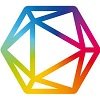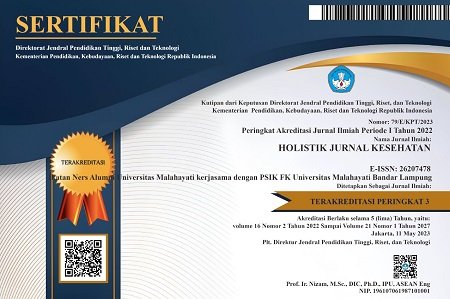Pengaruh latihan range of motion (ROM) ankle terhadap pencegahan terjadinya neuropati dan angiopati pada klien diabetes melitus
Abstract
The effect of range motion (ROM) ankle exercise on prevention of neuropathy and angiopathy in patient with diabetes mellitus
Background: Based on data from Basic Health Research (2013) conducted by the Indonesian Ministry of Health in a way to obtain the proportion of DM at the age of 15 years and over, confirmed / checked whether or not they suffer from DM or not.It was found that Lampung Province was ranked as the 8th largest DM person from 33 provinces throughout Indonesia, with DM patients with 38,923 lives and 5,560 people. One complication that needs attention is diabetes foot injury and it can cause amputation. The most common cause of diabetes foot injury is peripheral neuropathy which includes damage to sensory, autonomic and motor nerves.
Purpose: The purpose of this study was to determine the effect of Range of Motion (ROM) ankle exercise on prevention of neuropathy and angiopathy on diabetes patients.
Methods: A quasi experimental pre and post- test with control group study design was employed. The purposive sampling with 26 participants (13 respondents intervention group and 13 respondents control group) were recruited. The interventions groups performed ROM ankle exercise in their own respective training programs for 4 weeks, whereas no training was done in the control group. Both groups intervention and control, before and after the exercise program were measured with monofilament test for neuropathy and Venous Doppler for angiopathy. The data analysis was using t-test.
Results: In the intervention group there were a significant improvements after ROM ankle exercise on prevention of neuropathy with p Value 0.000 and for angiopathy with p Value 0.000. There were significant different between intervention group and control group for neuropathy (p: .004) and angiopathy (p: .031).
Conclusion: To prevent neuropathy and angiopathy on diabetes patients a home exercise program with Range of Motion (ROM) ankle could be implemented
Keywords: Range of Motion; Neuropathy; Angiopathy; Diabetes Mellitus
Pendahuluan: Berdasarkan Riskesdas tahun 2013 oleh Kemenkes RI dengan melakukan wawan cara untuk mendapatkan proporsi DM pada usia 15 tahun keatas yaitu proporsi penduduk yang terdiagnosis menderita DM dan penduduk yang belum pernah didiagnosis menderita DM. Provinsi Lampung menduduki peringkat ke – 8 penyandang DM terbesar dari 33 Provinsi diseluruh Indonesia, 38.923 jiwa dan 5.560 jiwa . Salah satu komplikasi yang harus mendapat perhatian yaitu luka kaki diabetes karena dapat mengakibarkan amputasi. Penyebab terbanyak dari luka kaki diabetes yaitu neuropati perifer yang meliputi kerusakan syaraf sensorik, otonom dan motorik.
Tujuan: Diketahui pengaruh Range Of Motion (ROM) Ankle terhadap pencegahan terjadinya Neuropati dan Angiopati pada pasien Diabetes Melitus.
Metode: Penelitian ini mengunakan desain quasi eksperimen pre post test dengan kelompok control dan intervensi..Sampel diambil dengan menggunakan tehnik Purposive Sampling dengan jumlah sampel yaitu 26 responden. Instrument penelitian ini menggunakan 10 gr semmens weinstein monofilament untuk mendeteksi Neuropati dan Venous Doppler Ultrasound untuk mendeteksi angiopati.
Hasil: Menunjukkan adanya pengaruh latihan Range of Motion (ROM) Ankle terhadap pencegahan neuropati dengan p Value 0.000 dan angiopati dengan p Value 0.000. Terdapat perbedaan bermakna antara kelompok intervensi dan control untuk neuropati (p: .004) dan angiopati (p: .031).
Simpulan: Untuk mencegah terjadinya neuropati dan angiopati pada penderita DM untuk dapat melakukan latihan Range of Motion (ROM) Ankle dirumah
Keywords
Full Text:
PDFReferences
Atlas Diabetes. (2015). International diabetes federation. IDF Diabetes Atlas, 7th edn. Brussels, Belgium: International Diabetes Federation.
Benbow, M. (2009). Fungating malignant wounds and their management. Journal of Community Nursing, 23(11).
Bryant, R., & Nix, D. (2015). Acute and chronic wounds: current management concepts. Elsevier Health Sciences.
Damayanti, N. (2012). Buku pintar panduan bimbingan konseling. Yogyakarta: Araska.
DeLaune, S. C., & Ladner, P. K. (2002). Fundamentals of Nursing: Standards & Practice (Nursing Education).
Departemen Kesehatan Republik Indonesia. (2013). Riset kesehatan dasar tahun 2013. Jakarta: Badan Penelitian dan Pengembangan Departemen Kesehatan Republik Indonesia.
Ernawati, E., Setiawati, E. P., & Kurniawan, T. (2015). Pengaruh Motivasi Internal dan Eksternal terhadap Diabetes Self Management di Wilayah Kecamatan Gombong Kabupaten Kebumen. Jurnal Sistem Kesehatan, 1(2)
Ernawati. (2013). Penatalaksanaan Keperawatan Diabetes Melitus Terpadu. Jakarta: Mitra Wacana Media.
Hidayah, A. (2012). Tingkat pengetahuan pasien diabetes mellitus tentang risiko terjadinya ulkus kaki diabetes di Poli klinik Penyakit Dalam Rumah Sakit Umum Pusat Haji Adam Malik medan.
Isdiany, N., & Rosmana, D. (2014). Indeks Glikemik, Beban Glikemik, dan Asupan Energi Berperan dalam Pengendalian Kadar Glukosa Darah Penderita DM Tipe 2. Jurnal Riset Kesehatan, 7(1).
Lukita, Y. I., Widyati, N., & Wantiyah, W. (2018). Pengaruh Range of Motion (ROM) Aktif Kaki terhadap Risiko terjadinya Ulkus Kaki Diabetik pada Pasien Diabetes Mellitus Tipe 2 di Desa Kaliwining Kabupaten Jember (The Effect of Active Leg Range of Motion on the Risk of Diabetik Foot Ulcer in Patient with. Pustaka Kesehatan, 6(2), 305-311.
Maryunani, A. (2013). Step By Step Perawatan Luka Diabetes Dengan Metode Perawatan Luka Modern. Bogor: In Media.
Nursiswati, N., Halfens, R. J., & Lohrmann, C. (2017). Change in care dependency of stroke patients: A longitudinal and multicenter study. Asian nursing research, 11(2), 113-118.
Pengurus Besar Perkumpulan Endokrinologi Indonesia (2015). Konsensus pengelolaan dan pencegahan diabetes melitus tipe 2 di Indonesia. Jakarta: PB Perkeni.
Rangkuti, I. Y. (2011). Hubungan Antara Diabetes Melitus Tipe 2 Dengan Retinopati Diabetik Dikaji Dari HbA1c Sebagai Parameter Kontrol Gula Darah (Master's thesis).
Rosidah, A. (2016). Bimbingan kelompok melalui teknik problem solving untuk meningkatkan penyesuaian diri siswa terisolir. Jurnal Fokus Konseling, 2(2).
Rusandi, D. (2014). Pengaruh Senam Kaki Diabetes Terhadap Tingkat Sensitivitas Kaki Dan Kadar Glukosa Darah Pada Penderita Diabetes Melitus Di Kelurahan Banyuraden Gamping Sleman (Doctoral dissertation, STIKES Jenderal Achmad Yani Yogyakarta).
Sari, C. W. M., Haroen, H., & Nursiswati, N. (2016). Pengaruh Program Edukasi Perawatan Kaki Berbasis Keluarga terhadap Perilaku Perawatan Kaki pada Pasien Diabetes Melitus Tipe 2. Jurnal Keperawatan Padjadjaran, 4(3).
Sari, Y. (2015). Perawatan luka diabetes. Yogyakarta: Graha Ilmu
Taufiq, I. (2011). Pengaruh latihan Range of Motion (ROM) ankle terhadap proses penyembuhan ulkus kaki diabetik di RSUD Dr. Hi. Abdul Moeloek dan RSUD Jendral A. Yani Propinsi Lampung (Doctoral dissertation, Tesis, Fakultas Ilmu Keperawatan, Program Magister Ilmu Keperawatan, Universitas Indonesia, Depok).
Wahyuni, A. (2016). Senam Kaki Diabetik Efektif Meningkatkan Ankle Brachial Index Pasien Diabetes Melitus Tipe 2. Jurnal Ipteks Terapan, 9(2), 19-27.
Widyawati, I. (2010). Pengaruh latihan rentang gerak sendi bawah secara aktif (active lower range of motion exercise) terhadap tanda dan gejala neuropati diabetikum pada penderita diabetes mellitus tipe II di persadia U IT RSU Dr. Soetomo Surabaya.
Wound Ostomy and Continence Nurses. (2003). Continence Nurses Society. Guideline for prevention and management of pressure ulcers, 11-17.
Yunus, B. (2015). Faktor-faktor yang Mempengaruhi Lama Penyembuhan Luka pada Pasien ULKUS Diabetikum di Rumah Perawatan ETN Centre Makassar (Doctoral dissertation, UIN Alauddin Makassar).
DOI: https://doi.org/10.33024/hjk.v13i3.1941
Refbacks
- There are currently no refbacks.
Copyright (c) 2019 Holistik Jurnal Kesehatan

This work is licensed under a Creative Commons Attribution-NonCommercial 4.0 International License.














